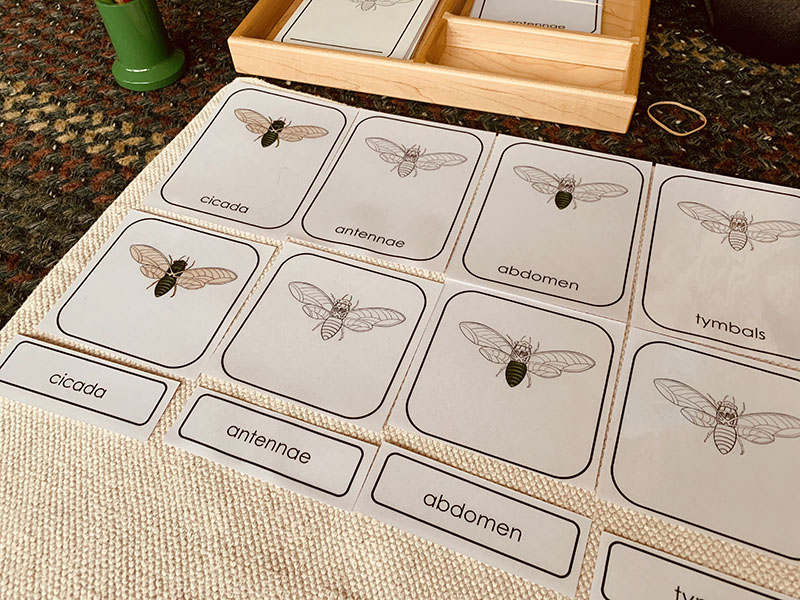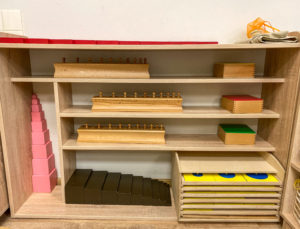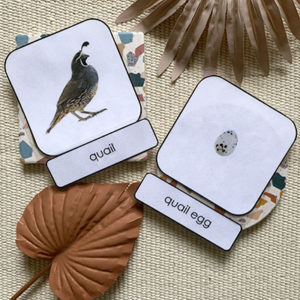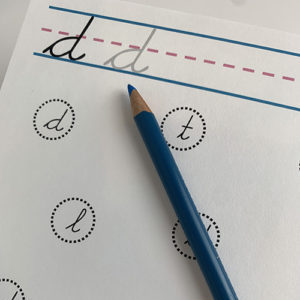
In the ever-evolving world of education, Montessori methods have stood the test of time. One powerful tool utilized in Montessori classrooms are the 3 part cards, also known as nomenclature cards. These seemingly simple cards might appear unassuming at first glance, but their impact on a child’s development is immense. Designed to introduce children to vocabulary, concepts, and the world around them, Montessori nomenclature cards are a valuable resource that fosters language acquisition, cognitive development, and critical thinking skills. By combining visual and written cues, these cards engage children in active learning, sparking curiosity and promoting independent exploration. They are a classic tool that allows teachers to checks for comprehension indirectly, without making the child feel like they are being tested. Whether used in the classroom or at home, Montessori nomenclature cards provide a foundation for language development, vocabulary expansion, and a deeper understanding of the world, making them an essential tool for parents and educators alike.
What are Montessori Nomenclature Cards?
Although Montessori nomenclature cards look like flash cards, they used very differently. They are a set of educational cards that feature an image or illustration as well as a corresponding word or phrase. These cards are used to introduce children to various objects, concepts, and vocabulary, allowing them to make connections between words and their visual representations. The cards cover a wide range of topics, including nature, animals, plants, everyday objects, and more. Each set of nomenclature cards can me used in such a way as to align with the child’s developmental stage and interests, ensuring that the learning experience is engaging and relevant.
DIY Montessori Nomenclature Cards: How to create your own
Creating your own set of Montessori Nomenclature Cards can be a rewarding and cost-effective way to provide personalized learning materials for your child or students. Here’s a step-by-step guide to making DIY Montessori Nomenclature Cards:
-
Choose a Theme:
Decide on a theme or topic for your cards. It could be animals, plants, household objects, or anything else that aligns with the child’s interests and learning goals. -
Gather Images:
Collect high-quality images or illustrations that represent the vocabulary you want to introduce. You can find copyright-free images online or use your own photographs. -
Write the Words:
Write the corresponding words or phrases on separate cards. Use clear and legible handwriting or print them using a computer. -
Pair the Images and Words:
Glue or tape the images on one side of the cards and write the corresponding words on the other side. Ensure that the cards are sturdy and durable. -
Laminate the Cards:
To protect the cards from wear and tear, consider laminating them. This step will increase their longevity and make them easier to clean. -
Organize and Store:
Arrange the cards in a systematic manner, grouping them according to categories or themes. Store them in labeled boxes or trays for easy access.
Creating DIY Montessori nomenclature cards allows you to customize the learning materials based on the child’s specific needs and interests. It also provides an opportunity for hands-on involvement, fostering a sense of ownership and creativity. I have a free Nomenclature Cards PowerPoint template available for download in my Teachers Pay Teachers store if you want to use that.
Benefits of using Montessori Nomenclature Cards in child development
The use of Montessori Nomenclature Cards offers numerous benefits for a child’s overall development. These cards go beyond mere vocabulary building and provide a solid foundation for various aspects of learning and growth. Let’s explore some of the key benefits:
1. How Montessori Nomenclature Cards aid in language development
Language development is a crucial aspect of a child’s growth, and Montessori nomenclature cards play a significant role in enhancing this essential skill. By pairing words with corresponding images, these cards help children associate meaning with the written and spoken language. When children see the image and hear the word simultaneously, it reinforces their understanding of the vocabulary and improves their ability to express themselves.
Moreover, Montessori nomenclature cards introduce children to new words and concepts, expanding their vocabulary and language fluency. As children explore different sets of cards, they encounter words they might not encounter in their everyday lives, broadening their knowledge and understanding of the world around them. This exposure to a rich and diverse vocabulary sets the stage for successful language development in the long run.
2. Enhancing vocabulary and literacy skills with Montessori Nomenclature Cards
Building upon the previous point, Montessori Nomenclature Cards are an excellent tool for enhancing vocabulary and literacy skills. Vocabulary development is closely linked to reading comprehension and overall academic success. By using these cards, children not only learn new words but also gain a deeper understanding of their meanings and contexts. This expanded vocabulary serves as a solid foundation for reading, writing, and effective communication.
In addition to vocabulary enrichment, Montessori Nomenclature Cards also promote early literacy skills. As children engage with the cards, they develop phonemic awareness, letter recognition, and phonics skills. The visual cues on the cards help children associate sounds with letters, which is crucial for learning to read and write. The combination of visual and written information on the cards creates a multisensory learning experience that supports the development of strong literacy skills.
3. Improving cognitive skills through Montessori Nomenclature Cards
Cognitive development is a fundamental aspect of a child’s overall growth, and Montessori nomenclature cards provide valuable opportunities to enhance cognitive skills. The act of matching words with corresponding images requires critical thinking, problem-solving, and visual discrimination skills. Children must analyze the image, recall the corresponding word, and make connections between the two.
Furthermore, Montessori nomenclature cards encourage categorization and classification skills. As children explore different sets of cards, they learn to group similar objects or concepts together, developing their ability to organize and make sense of the world around them. This cognitive exercise strengthens their logical reasoning and helps them make connections between different ideas.
4. Montessori Nomenclature Cards for sensory development
Sensory development plays a vital role in a child’s early years, and Montessori nomenclature cards provide a sensory-rich learning experience. The tactile sensation of holding and manipulating the cards stimulates the child’s sense of touch and fine motor skills. As children handle the cards, they develop hand-eye coordination, dexterity, and finger strength.
Additionally, the visual and auditory aspects of the cards engage the child’s senses of sight and hearing. The colorful images and clear pronunciation of words capture the child’s attention and promote visual and auditory discrimination. This sensory stimulation fosters the child’s ability to observe, absorb information, and make connections between different sensory inputs.
Implementing Montessori Nomenclature Cards in a classroom setting
Montessori nomenclature cards are widely used in Montessori classrooms due to their effectiveness in promoting active learning and independent exploration. Educators can incorporate these cards into various activities to support different areas of development. Primarily, you will use the 3 period lesson as the child’s first lesson with any set of cards.
Using the 3 Period Lesson
Choose 3-4 cards at a time and place them in front of the child one by one, saying the name and asking the child to repeat the name.
First period:
Place image of a dog on a mat.
This is a dog.
Ask the child to repeat the name.
Then repeat these steps with each image: cat, bird, snake, etc.
Second period:
Make this fun! Tell the child you are now going to mix up the order of the cards and see if they can remember the names of the images.
Show me the dog.
Put the picture of the bird above your head like it’s flying.
Pick up the picture of cat. Put the picture of the cat back down.
Point to the snake.
If you have done this for a while, mixed up the cards several times and the child has no difficulty with this stage, move on to the third period. If the child is still getting mixed up, you can actually just circle right back to the first period. Remove 1-2 cards and try again until the second period comes with ease. You may even need to end the lesson and try it another day. That is absolutely fine. Follow the child.
Third period:
When the child is ready we ask the child to give the name of the image we choose.
What is this?
If the child answers with ease, we consider the lesson complete and we can always check for retention again another day. If the child has trouble with this, we can circle back to the second or first periods any time we need to and as many times as needed.
Once we have worked with the images and the child knows the names solidly we introduce the 3 cards together – we will place the card with the image and label on it and say “This is a dog. This says dog. Can you match the picture of the dog? Can you match the word that says dog?” At this stage the child is doing purposeful work. They know the names of the images, they can match the images and words, and depending on where they are in their writing and reading skills, they may be able to read and write some of the words and be interested in making a booklet. As you can see, these simple cards create ongoing opportunities to learn and deepen understanding with many phases to revisit and extensions to do.
Additional uses for Montessori nomenclature cards:
-
Matching Games:
Create matching games where children have to pair the correct image with its corresponding word. This activity enhances visual discrimination, memory, and vocabulary skills. -
Sorting and Categorization:
Provide a set of cards representing different categories and ask children to sort them accordingly. This activity promotes critical thinking, categorization skills, and logical reasoning. -
Storytelling and Language Development:
Use Montessori Nomenclature Cards as story prompts. Encourage children to create stories using the cards, incorporating the vocabulary and concepts they have learned. This activity fosters creativity, language fluency, and narrative skills. -
Research and Exploration:
Introduce a set of cards related to a specific topic or theme and encourage children to explore further by conducting research or engaging in hands-on activities. This approach supports independent learning, curiosity, and problem-solving skills.
By incorporating Montessori Nomenclature Cards into the daily routine, educators create an engaging and interactive learning environment that caters to each child’s unique developmental needs.







